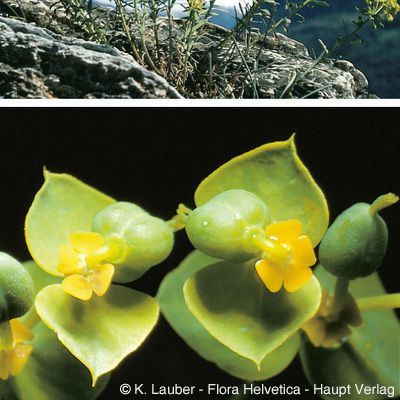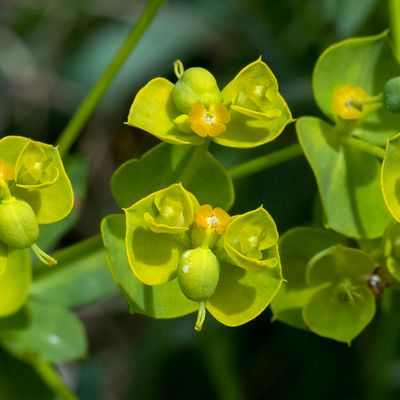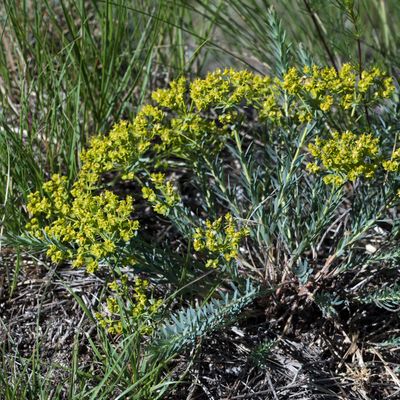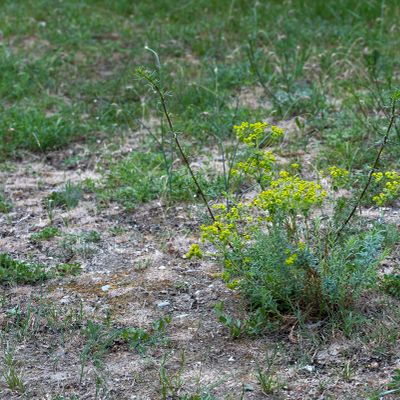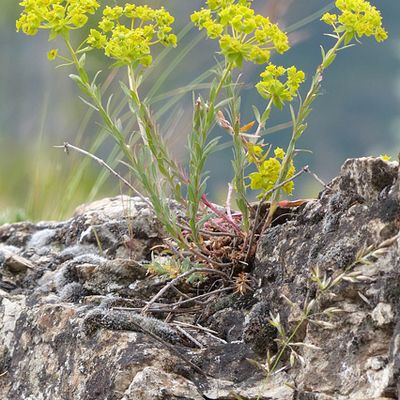Euphorbia seguieriana Neck. subsp. seguieriana
1018430
Subspecies
ISFS : 161300
Checklist : 1018430
ISFS : 161300
Checklist : 1018430
Contains :
Synthesis
Species description (© Flora Helvetica 2018)
20-60 cm hoch, kahl, mit mehreren aufrechten oder aufsteigenden, unverzweigten Stängeln. Blätter schmal-lanzettlich, ganzrandig, 1-3 cm lang, blaugrün. Blütenstand 8-15strahlig, die Strahlen meist 1-2mal gabelig verzweigt. Tragblätter ähnlich wie die Stängelblätter. Hüllbecher mit schief-ovalen, gelben Drüsen. Frucht glatt oder fein punktiert. Samen grau bis braun, glatt.Flowering period (© Flora Helvetica 2018)
5-7Habitat and distribution inside Switzerland (© Flora Helvetica 2018)
Trockenwiesen, steinige und sandige kalkhaltige Böden / kollin-subalpin / VS, ANW, GR (Puschlav), adventiv AGWorld distribution (© Flora Helvetica 2018)
Südeuropäisch-westasiatischEcological indicator (© Landolt & al. 2010)
142-44+5.c.2n=16Status
IUCN status
flora.fl.National Priority
--International responsibility
--Conservation
Threats
Distribution map
Habitat and distribution inside Switzerland
VS, ANW, GR (Puschlav), adventiv AGWorld distribution
Südeuropäisch-westasiatischEcology
Life form
Subfructicose chamaephyte
Habitats
Milieux Phytosuisse (© Prunier et al. 2017)
Habitats © Delarze & al. 2015
 | 3.3.1.5 - Trockenwarme Kalkschuttflur (Stipion calamagrostis) |
 | 4.2.1.1 - Inneralpine Felsensteppe (Stipo-Poion) |
 | 6.4.3 - Kontinentaler Steppen-Föhrenwald (Ononido-Pinion) |
bold
Dominant species, influencing the appearance of the habitat
 Character species
Character species
 Less strictly linked to a specific habitat
Less strictly linked to a specific habitat
Ecological indicator values by © Landolt & al. (2010)
| Soil factors | Climatic factors | Salinity tolerance | |||
|---|---|---|---|---|---|
| Humidity Value H | 1 | Light Value L | 4 | Salinity Index | -- |
| Reaction Value R | 4 | Temperature factor T | 4+ | ||
| Nutriments value N | 2 | Continentality K | 5 | ||
- Ecological values legend
Humidity Value H 1 very dry 1+ dry 2 moderatly dry 2+ moist 3 medium wet 3+ wet 4 very wet 4+ soggy 5 submerged or underwater f plants living in running water u mostly submerged plants v partly submerged, partly floating plants w humidity moderately variable (± scale of 1-2) w+ highly variable humidity (scale exceeding ± 2) Reaction Value R 1 Very acid (pH 2.5-5.5) 2 acid (pH 3.5-6.5) 3 lightly acid to neutral (pH 4.5-7.5) 4 neutral to basic (pH 5.5-8.5) 5 basic (pH 6-5 -> 8.5 Nutriments value N 1 very low in nutrients 2 low in nutriments 3 medium-poor to medium-rich in nutrients 4 rich in nutriments 5 very rich in nutriments Salinity tolerance 1 halotolerant 3 halophyle Light Value L 1 very shady 2 shady 3 lighted areas 4 luminous 5 highly luminous Temperature factor T 1 alpine to nival stages (from the treeline to the snowline) 1+ suprasubalpine and upper subalpine levels (pine and larch forests) 2 subalpine level (coniferous forests without beeches up to the upper limit of spruces) 2+ lower subalpine and upper mountain stages 3 mountain level (beech and silver fir forests, in the central Alps Scots pine forests) 3+ lower mountain and upper hill levels 4 hill level (mixed deciduous oak forests) 4+ hot places, hill level 5 very hot places, hill level (only in the hottest places, typical of southern Europe) Continentality K 1 Atlantic (high air humidity, very low temperature variations, mild winters) 2 Sub-Atlantic (high air humidity, low temperature variations, relatively mild winters) 3 sub-Atlantic to subcontinental (average air humidity, moderately variable temperature, slightly low winter temperatures) 4 subcontinental (low air humidity, large temperature variations, rather cold winters) 5 continental (very low air humidity, very large temperature variations, cold winters)
Water dependency
| Rivers | |
| Calm water | |
| Ground water |
Nomenclature
Accepted Name (Checklist 2017)
Euphorbia seguieriana Neck. subsp. seguieriana
Vernacular name
Deutscher Name :
Steppen-Wolfsmilch, Séguiers WolfsmilchNom français :
Euphorbe des steppesNome italiano :
Euforbia di SéguierMatch with other reference books
| Relation | Nom | Book | No |
|---|---|---|---|
| = | Euphorbia seguieriana Neck. subsp. seguieriana | Checklist 2017 | 161300 |
| = | Euphorbia seguieriana Neck. s.str. | Flora Helvetica 2001 | 1315 |
| = | Euphorbia seguieriana Neck. s.str. | Flora Helvetica 2012 | 797 |
| = | Euphorbia seguieriana Neck. subsp. seguieriana | Flora Helvetica 2018 | 797 |
| = | Euphorbia seguieriana subsp. loiseleurii (Rouy) Greuter & Burdet | Index synonymique 1996 | 161400 |
| = | Euphorbia seguieriana Neck. s.str. | Index synonymique 1996 | 161300 |
| = | Euphorbia seguieriana Neck. s.str. | Landolt 1977 | 1950 |
| = | Euphorbia seguieriana Neck. s.str. | Landolt 1991 | 1598 |
| = | Euphorbia seguieriana Neck. s.str. | SISF/ISFS 2 | 161300 |
| = | Euphorbia seguieriana subsp. loiseleurii (Rouy) Greuter & Burdet | SISF/ISFS 2 | 161400 |
| = | Euphorbia seguieriana Neck. s.str. | Welten & Sutter 1982 | 977 |
= The taxon corresponds to the accepted taxon (Checklist 2017)
< The taxon is included in the accepted taxon (Checklist 2017)
> The taxon includes (among others) also the accepted taxon (Checklist 2017)
< The taxon is included in the accepted taxon (Checklist 2017)
> The taxon includes (among others) also the accepted taxon (Checklist 2017)
Checklist 2017 comments
Neues Konzept: Das Taxon wird gegenüber dem SISF-2 weiter gefasst. Enthält E. seguieriana subsp. loiseleurii sensu Aeschimann & Burdet welche lediglich einer Kümmerform des Typus entspricht. E. seguieriana subsp. loiseleurii (Rouy) Greuter & Burdet ist ein für den ausserhalb des Gebietes der Checklist 2017 gelegenen Mont Ventoux endemisches Taxon. Wegfall des Ausdrucks s.str.: Alle «im engeren Sinn» (sensu stricto, s.str.) gefassten Arten werden neu in Unterarten mit gleichlautendem Unterart-Epithet gefasst (autonyme Unterart). Die Zuordnung zur Unterart sollte nur erfolgen, wenn ihre Bestimmung als solche sichergestellt ist.
Checklist
Status
Native status
-IUCN list of endangered species (© Walter & Gillett 1997) : No
Status on national Red List
| NO INFORMATION |
National Priority Species List Status
| National Priority | -- |
| Need to take action | -- |
| International responsibility | -- |
| Need to monitor populations | -- |
Protection status
| No international, national or cantonal protection |
- Disclaimer
InfoFlora compiles information on protected species as accurately as possible, taking it from the respective cantonal laws. In some cases, however, it was not possible to use the plant names as listed in the original text, but an interpretation of their taxonomy or nomenclature was necessary. The exact meaning of the categories „completely protected“ and „partially protected“ differs among the cantons.
InfoFlora cannot guarantee that the information on the protection status is correct and complete. In case of doubts, we recommend to look up the texts of the respective cantonal law.
Status by sector of activity
| Agriculture-related environmental objectives : | more informations | |
| Forest management environmental objectives : | more informations |
